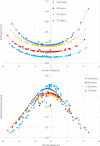Optimizing the ULV-VFQ for Clinical Use Through Item Set Reduction: Psychometric Properties and Trade-Offs
- PMID: 28573076
- PMCID: PMC5450924
- DOI: 10.1167/tvst.6.3.12
Optimizing the ULV-VFQ for Clinical Use Through Item Set Reduction: Psychometric Properties and Trade-Offs
Abstract
Purpose: We examine the dimensionality of the 150-item visual functioning questionnaire for individuals with ultralow vision (ULV-VFQ) and develop representative abbreviated versions, facilitating clinical use, while retaining compatibility with a 17-item performance assessment.
Methods: Subsets with 50 and 23 items covering the full difficulty range were selected, with evenly spaced item measures (IMs) and good representation of visual aspects and functional domains. Person measures (PMs) for the anchored subsets were derived through Rasch analysis of data from 80 respondents.
Results: Fit statistics for the reduced item sets were similar to those for the full set, with reliabilities at or above 95%. Mean PMs in the reduced sets were within 0.8 standard errors (SEs) of those in the full set. SEs of the PMs increased from the SE for 150 items, roughly in inverse proportion with the square root of the set size. Unexplained variance levels (24%-27%) and variance of the first unexplained factor (3.3%-3.9%) were close to those (30% and 2.6%) for 150 items. Differential item functions for omitted items were negligible. Aspects and domains are adequately represented in the reduced sets.
Conclusions: Self-reported visual ability can be measured accurately using appropriately chosen anchored subsets of the ULV-VFQ. Functional ability of individuals with ULV is characterized adequately by a single dimension.
Translational relevance: The ULV-VFQ50 and ULV-VFQ23, using anchored IMs from the 150-item ULV-VFQ, provide an efficient and reliable self-report assessment of visual ability in individuals whose visual impairment is too severe for assessment with VFQs currently in use.
Keywords: low vision rehabilitation; patient-reported outcomes; prosthetic vision; ultralow vision; visual functioning questionnaire.
Figures





Similar articles
-
Development of the Ultra-Low Vision Visual Functioning Questionnaire (ULV-VFQ).Transl Vis Sci Technol. 2017 May 31;6(3):11. doi: 10.1167/tvst.6.3.11. eCollection 2017 May. Transl Vis Sci Technol. 2017. PMID: 28573075 Free PMC article.
-
Self-Reported Visual Ability Versus Task Performance in Individuals With Ultra-Low Vision.Transl Vis Sci Technol. 2023 Oct 3;12(10):14. doi: 10.1167/tvst.12.10.14. Transl Vis Sci Technol. 2023. PMID: 37847202 Free PMC article.
-
Development of The Chinese Version of Ultra-Low Vision Visual Functioning Questionnaire-150.Transl Vis Sci Technol. 2023 Jun 1;12(6):9. doi: 10.1167/tvst.12.6.9. Transl Vis Sci Technol. 2023. PMID: 37310736 Free PMC article.
-
Measuring visually guided motor performance in ultra low vision using virtual reality.Front Neurosci. 2023 Dec 20;17:1251935. doi: 10.3389/fnins.2023.1251935. eCollection 2023. Front Neurosci. 2023. PMID: 38178831 Free PMC article.
-
The Activity Inventory: an adaptive visual function questionnaire.Optom Vis Sci. 2007 Aug;84(8):763-74. doi: 10.1097/OPX.0b013e3181339efd. Optom Vis Sci. 2007. PMID: 17700339 Free PMC article.
Cited by
-
Perspectives on Gene Therapy: Choroideremia Represents a Challenging Model for the Treatment of Other Inherited Retinal Degenerations.Transl Vis Sci Technol. 2020 Feb 14;9(3):17. doi: 10.1167/tvst.9.3.17. Transl Vis Sci Technol. 2020. PMID: 32714643 Free PMC article.
-
Development of the Ultra-Low Vision Visual Functioning Questionnaire (ULV-VFQ).Transl Vis Sci Technol. 2017 May 31;6(3):11. doi: 10.1167/tvst.6.3.11. eCollection 2017 May. Transl Vis Sci Technol. 2017. PMID: 28573075 Free PMC article.
-
An update on retinal prostheses.Clin Neurophysiol. 2020 Jun;131(6):1383-1398. doi: 10.1016/j.clinph.2019.11.029. Epub 2019 Dec 10. Clin Neurophysiol. 2020. PMID: 31866339 Free PMC article. Review.
-
Harmonization of Outcomes and Vision Endpoints in Vision Restoration Trials: Recommendations from the International HOVER Taskforce.Transl Vis Sci Technol. 2020 Jul 16;9(8):25. doi: 10.1167/tvst.9.8.25. eCollection 2020 Jul. Transl Vis Sci Technol. 2020. PMID: 32864194 Free PMC article.
-
Self-Reported Visual Ability Versus Task Performance in Individuals With Ultra-Low Vision.Transl Vis Sci Technol. 2023 Oct 3;12(10):14. doi: 10.1167/tvst.12.10.14. Transl Vis Sci Technol. 2023. PMID: 37847202 Free PMC article.
References
-
- Stelmack JA,, Tang XC,, Wei Y,, Massof RW. The effectiveness of low-vision rehabilitation in 2 cohorts derived from the veterans affairs Low-Vision Intervention Trial. Arch Ophthalmol. 2012; 130: 1162– 1168. - PubMed
-
- Massof RW. The measurement of vision disability. Optom Vis Sci. 2002; 79: 516– 552. - PubMed
-
- Geruschat DR,, Dagnelie G. Restoration of vision following long-term blindness: considerations for providing rehabilitation. J Vis Impair Blind. 2016; 110: 5– 13.
-
- Finger RP,, Tellis B,, Crewe J,, Keeffe JE,, Ayton LN,, Guymer RH. Developing the impact of Vision Impairment-Very Low Vision (IVI-VLV) questionnaire as part of the LoVADA protocol. Invest Ophthalmol Vis Sci. 2014; 55: 6150– 6158. - PubMed
Grants and funding
LinkOut - more resources
Full Text Sources
Other Literature Sources

